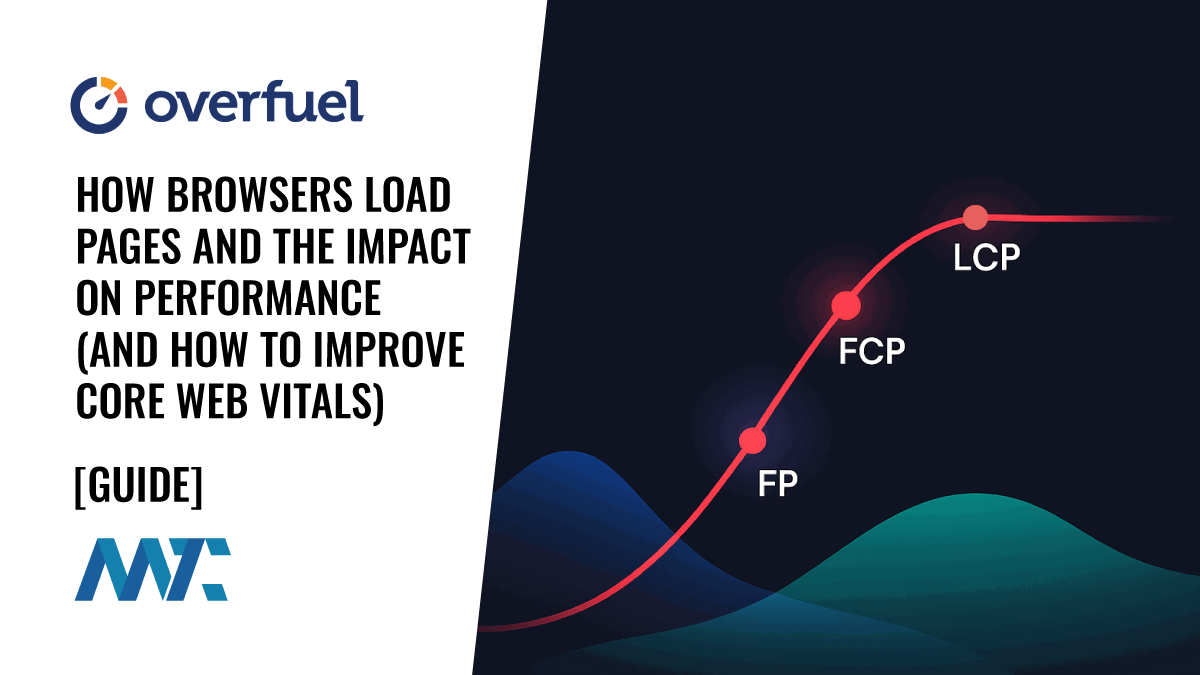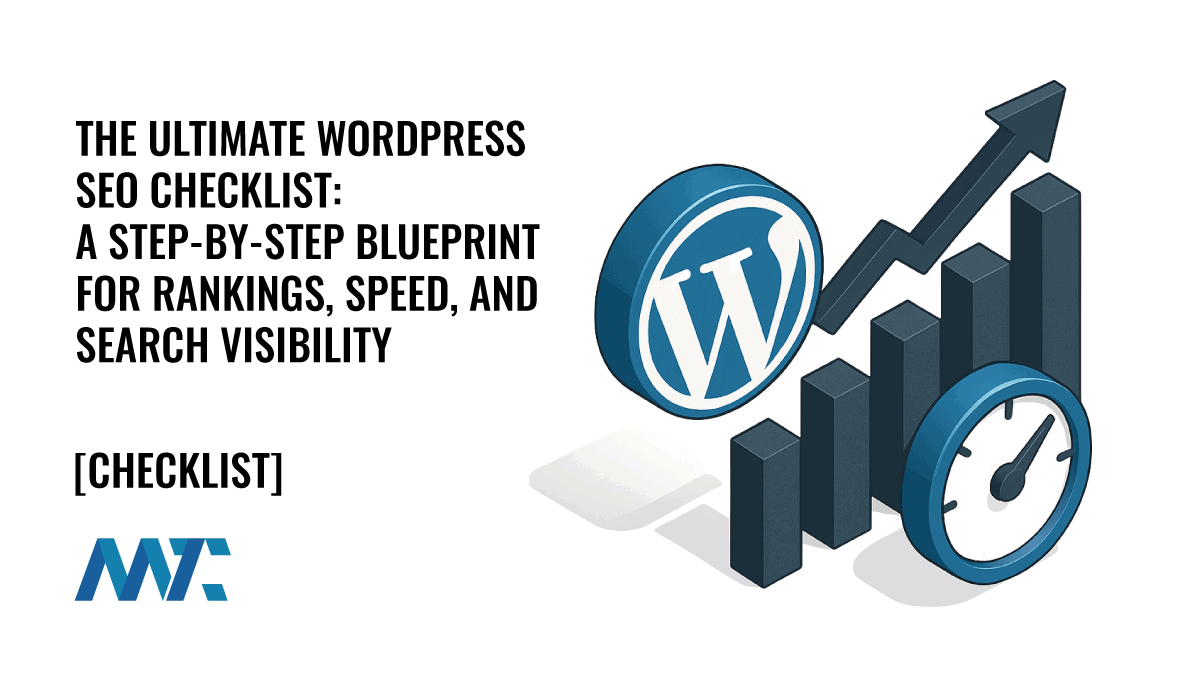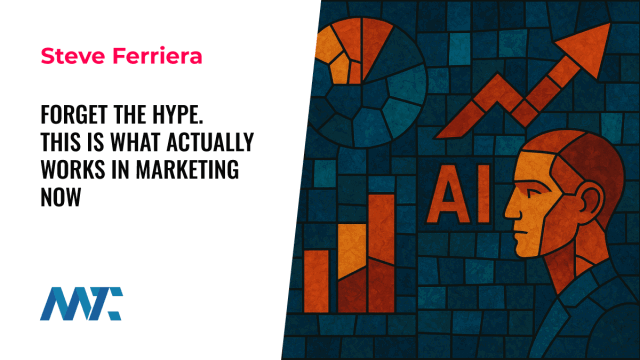How Browsers Load Pages, Its Impact on Performance, And How To Improve CWV

A key reason I decided to assist Overfuel was that the development team recognized the significance of page speed on every aspect of search engine visibility and user experience. They’ve built the fastest auto dealer website platform on the planet… and all client results have far surpassed expectations. Keep in mind that a high-speed site doesn’t just solve organic challenges; it also boosts your paid search performance, social media engagement, and any other medium or channel where you’re driving visitors to your website. Best of all, a fast and well-designed site drives conversions.
How Do Browsers Load Pages?
Delivering a fast, responsive web experience requires understanding every stage of how a browser loads and displays a page, the network rules it plays by, and the strategies you can use to optimize each stage for speed, efficiency, and Core Web Vitals (CWV). What happens between the moment a user clicks a link and the instant your content appears is not a mystery—it’s a complex series of interactions between the browser, the network, and your server. Every millisecond in that process can impact whether a visitor stays engaged or bounces away.
From a search visibility perspective, this knowledge is essential. Search engines like Google now factor page speed and user experience metrics directly into their ranking algorithms. Sites that are sluggish or poorly optimized not only frustrate users but also risk slipping below faster, better-performing competitors in search results. Core Web Vitals are measurable signals that reflect how quickly and smoothly your site loads and becomes interactive. Understanding the browser’s decision-making process during loading is the foundation for improving these metrics and securing stronger organic visibility.
On the user experience side, browser performance optimization is about removing friction. Users expect instant responsiveness—hesitation or visible layout shifts break the sense of flow and trust. By mastering how browsers fetch, parse, and render content—and by knowing how connection limits, protocol behavior, and asset delivery strategies work—you can make deliberate, informed choices that keep pages lightweight, interactions snappy, and experiences seamless across devices and network conditions. In a competitive digital environment, this isn’t just technical fine-tuning; it’s a core business advantage.
This guide serves as a comprehensive reference for understanding the browser’s page load process, the network and protocol rules that govern it, and the optimization techniques that can dramatically improve performance. It breaks down each stage of loading— from the first DNS lookup to the final paint—while mapping these actions to Core Web Vitals and modern connection limits. You’ll also find guidance on CDN strategy, asset optimization, minification, and compression, along with an actionable checklist for enhancing both search visibility and user experience (UX).
Table of Contents
Browser Page Load Timeline with Core Web Vitals
The Browser Page Load Timeline visually maps the sequence of actions a browser takes to fetch, render, and make a web page interactive. By viewing these steps against time, you can see exactly where key performance milestones occur.

Google uses these metrics to evaluate real-world user experience, and pages that fall short risk ranking penalties and reduced engagement.
Core Web Vitals
Each marker on the timeline corresponds to a measurable event that reflects either visual readiness or interactivity.
- First Paint (FP): Marks the moment the browser first renders anything to the screen, even if it’s just a background color. While not a Core Web Vital itself, it provides an early signal of visual progress.
- First Contentful Paint (FCP): The first time text, an image, or other meaningful content appears. Google views this as an indicator of how quickly users can perceive that something is happening. Slow FCP can make a page feel unresponsive from the outset.
- Largest Contentful Paint (LCP): The time it takes for the largest visible content element—often a hero image or main heading—to appear within the viewport. LCP is one of the three official Core Web Vitals, and Google recommends keeping it under 2.5 seconds for a good experience.
- First Input Delay (FID): Measures the delay between a user’s first interaction (click, tap, keypress) and the browser’s ability to respond. Long delays here often occur when the main thread is blocked by heavy JavaScript execution. FID is a Core Web Vital, with under 100 milliseconds considered good.
- Cumulative Layout Shift (CLS): While not a point on the timeline, CLS tracks unexpected visual movement during and after load. A low CLS ensures that elements don’t jump around, reducing frustration and accidental clicks.
By understanding when and why these events occur, you can better target performance improvements to the parts of the load sequence that matter most for search visibility and user satisfaction. The sections below break the timeline into stages—starting with navigation and connection setup—explaining each in detail and showing exactly how to optimize them for faster, more stable, and more responsive pages.
Stage 1: Navigation & Connection Setup
The page load journey begins the instant a user triggers navigation—whether by clicking a link, entering a URL, or submitting a form. In this stage, the browser determines where to get the requested resource, prepares network connections, and ensures a secure path for data exchange. Optimizing this stage reduces startup latency and sets the foundation for a fast load.
1. URL Parsing & Cache Lookup
The very first step in a browser’s journey to load a page begins the moment a user enters a web address, clicks a link, or triggers navigation in any way. The browser parses the URL to determine the protocol (HTTP or HTTPS), the domain name, the path, and any query parameters.
Before it ever reaches out to the network, the browser checks whether it already has a fresh, valid copy of the requested resource in its caches. This early lookup—spanning memory cache, disk cache, and service worker cache—can often bypass the need for DNS resolution, TCP/TLS handshakes, and network transfer entirely, delivering near-instant page loads for repeat visits or frequently used assets.
- Checks memory cache, disk cache, and service worker cache for a fresh copy.
- Memory cache:
- Disk cache:
- Saves resources to the user’s local storage so they persist across sessions.
- Access is slower than memory cache but still much faster than fetching over the network.
- Controlled by cache-related HTTP headers (
Cache-Control,Expires,ETag), which tells the browser how long it can reuse the file before revalidating with the server.
- Service worker cache:
- Managed by a site’s registered service worker script, allowing complete control over what is cached and how it is updated.
- Enables advanced patterns like offline access and background synchronization.
- Unlike standard browser caches, it’s programmable, so developers can cache specific API responses, version assets, and update them in the background without user intervention.
- If valid, the browser can serve instantly without network access.
2. DNS Resolution
Once the browser determines it needs to fetch a resource from the network, the first step is to translate the domain name into an IP address through the Domain Name System (DNS). The browser begins by checking its own DNS cache and, if necessary, the operating system’s cache for a recent lookup. If no cached entry exists, it sends a query to the configured DNS resolver—often provided by the user’s ISP or a public service like Cloudflare or Google Public DNS. In some cases, DNS resolution may be performed securely using DNS over HTTPS (DoH) or DNS over TLS (DoT), encrypting the request to protect privacy. This process ensures the browser knows exactly where to send the subsequent connection request.
- Translates hostname to IP address via:
- Local DNS cache
- OS resolver
- DNS server (optionally via DNS over HTTPS/TLS)
- Optimization: Use DNS-Prefetch for domains you know will be needed.
3. TCP Handshake
With the IP address in hand, the browser initiates a TCP (Transmission Control Protocol) handshake to establish a reliable connection to the server. This is a three-step exchange: the browser sends a SYN (synchronize) packet to the server, the server responds with a SYN-ACK (synchronize-acknowledge), and the browser replies with an ACK (acknowledge) to confirm. This handshake sets up the rules for communication, including port numbers and sequencing, ensuring both sides are ready to send and receive data in an orderly, error-checked manner.
- Establishes a connection with SYN → SYN-ACK → ACK sequence.
4. SSL/TLS Handshake (HTTPS)
If the connection uses HTTPS, the browser performs an SSL/TLS handshake after establishing TCP. In this step, the browser and server agree on the encryption protocol version (such as TLS 1.3), select compatible cipher suites, and exchange keys to enable secure communication. The server also sends its SSL/TLS certificate, which the browser validates against its trusted certificate authorities. In some cases, the browser may perform an OCSP (Online Certificate Status Protocol) check or use OCSP stapling to confirm the certificate’s validity. This process ensures that all subsequent communication is encrypted and that the server’s identity is verified.
- Negotiates protocol version (TLS 1.2/1.3) and cipher suites.
- Validates server certificate (may check via OCSP/CRL).
- Exchanges encryption keys for secure communication.
- Optimization: Enable TLS 1.3 for faster handshakes.
Stage 2: HTML Retrieval & Critical Path
Once the connection is ready, the browser requests the HTML document and prepares to fetch everything it needs to display the page. This is the point where server speed, caching strategy, and resource prioritization make the greatest impact on the time to first byte and the start of rendering.
5. HTTP Request/Response
Once a secure channel is established, the browser sends an HTTP request to the server. This request includes a method (typically GET for page loads), headers that describe the client environment and preferences, cookies for maintaining sessions, and sometimes a request body for methods like POST. The server processes the request and returns an HTTP response containing a status code (such as 200 OK, 301 Moved Permanently, or 404 Not Found), headers (content type, caching directives, compression information), and the HTML body. This HTML is the starting point for the browser to know what other assets it must fetch to render the page. If the response is a redirect, the browser repeats the earlier steps for the new URL.
- Browser sends request headers (cookies, cache-control, etc.).
- Server responds with status, headers, and HTML body.
- Redirects restart some connection steps.
6. Resource Hints
Modern browsers can act on performance hints embedded in HTML or response headers to optimize loading. These hints—such as preconnect, dns-prefetch, preload, and prefetch—help the browser anticipate and prepare for upcoming requests. For example, preconnect initiates a TCP/TLS handshake with another origin before it’s needed, while preload tells the browser to fetch a critical asset like a stylesheet or font immediately. Proper use of resource hints can shift connection setup and fetching earlier in the timeline, reducing delays on the critical rendering path.
- Preconnect: Warm up TCP/TLS to external origins.
- Preload: Immediately fetch high-priority assets (CSS, fonts, hero images).
- Prefetch: Low-priority fetch for likely future navigations.
- DNS-Prefetch: Resolve names ahead of time.
Stage 3: Parsing, Blocking, and Rendering
The browser begins transforming raw HTML into a usable structure, pausing when it encounters render-blocking resources like CSS or synchronous scripts. This is where good resource ordering and delivery practices can dramatically improve how quickly meaningful content appears to the user.
7. HTML Parsing & DOM Construction
The browser begins reading the HTML from top to bottom, converting it into a tree-like structure called the Document Object Model (DOM). As it parses, it encounters tags for text, images, scripts, and styles. CSS files are render-blocking by default—meaning the browser won’t paint content until styles are fetched and parsed—while scripts can also block parsing unless marked with async or defer. Efficient ordering of resources, minimizing blocking scripts, and inlining critical CSS can significantly improve how quickly visible content appears.
- Converts HTML to the DOM.
- Encounters render-blocking resources:
- CSS files: block until downloaded & parsed.
- JS files:
- No attribute → blocks parsing until executed.
async→ downloads in parallel, executes immediately when ready.defer→ downloads in parallel, executes after parsing completes.
8. CSSOM & Render Tree
When the browser fetches CSS files, it parses them into a CSS Object Model (CSSOM), a structured representation of all style rules. The DOM and CSSOM are then combined to form the render tree, which contains only the elements and styles needed for visible content. This process excludes hidden elements (like those with display: none). Building the render tree is a prerequisite for layout and paint, so delays in CSS delivery or parsing can directly impact Largest Contentful Paint (LCP).
- CSS files are parsed into CSSOM.
- DOM + CSSOM = render tree (visible nodes and computed styles).
Stage 4: Layout, Paint, and Interaction
With the DOM and styles ready, the browser calculates element positions, paints the pixels, and assembles the final visual output. Careful layout stability, efficient painting, and optimized compositing are crucial here to avoid visual delays and layout shifts.
9. Layout (Reflow)
With the render tree complete, the browser calculates the position and size of every visible element on the page. This stage, known as layout or reflow, determines where each piece of content fits within the viewport. Any changes that require recalculating positions—such as adding new elements above existing content—can trigger additional reflows, which can be costly in performance and may cause layout shifts that hurt Cumulative Layout Shift (CLS) scores.
- Calculates the geometry and position of elements.
- Late layout changes here contribute to CLS.
10. Paint
Once the layout is finalized, the browser paints each element’s pixels—text, images, backgrounds, borders—onto layers. Painting is the process of turning abstract shapes and styles into visual output. Heavy visual effects like shadows, gradients, or complex SVGs can slow painting, particularly on lower-powered devices. Optimizing these can reduce the time between layout and First Contentful Paint (FCP).
- Fills pixels for text, images, and backgrounds.
11. Compositing
The final visual assembly happens during compositing. Here, the browser takes the painted layers and combines them into a single image for the user to see. Certain CSS properties—such as transforms, opacity changes, and animations—can promote elements to their own layers, which are composited separately. While this can improve animation smoothness, too many layers can also add overhead. Balancing layer usage is key to smooth rendering.
- Layers are merged into a final bitmap and displayed.
Stage 5: Asset Loading & Request Types
Beyond the HTML and CSS, the browser loads images, fonts, media, scripts, and third-party embeds—each with its own performance considerations. How these assets are fetched, compressed, and prioritized can significantly influence Core Web Vitals.
Typical request types during a page load include:
- HTML document
- CSS stylesheets
- JavaScript (sync, async, defer)
- Images (
<img>, background, srcset) - Fonts (WOFF2, WOFF, TTF)
- Video/audio media
- XHR / Fetch API calls
- WebSocket connections
- Service worker requests
- DNS-prefetch
- Preconnect
- Preload
- Prefetch
- Beacon API calls
- Third-party embeds (iframes, ads, widgets)
- Analytics/tracking pixels
Stage 6: Post-Load Activities
Even after the page appears loaded, the browser remains busy. Scripts initialize, background tasks run, and service workers may install or update. Managing this stage ensures the site remains responsive, stable, and ready for the user’s next interaction.
12. JavaScript Execution
Even after the initial render, JavaScript continues to execute. Event listeners attach, analytics scripts initialize, and deferred or asynchronous scripts run. If this code is heavy or monopolizes the main thread, it can delay user interactions, impacting First Input Delay (FID) or Interaction to Next Paint (INP). Breaking up large tasks, using requestIdleCallback for non-urgent work, and offloading computation to Web Workers can improve responsiveness.
13. Idle Tasks
During idle time, the browser may perform background tasks like cleaning up memory, preloading resources for likely next navigations, or installing/updating service workers. This is an opportunity for developers to schedule low-priority work without affecting interactivity. Overloading idle periods, however, can still introduce performance hiccups if the user suddenly interacts with the page.
- Preloading future navigations.
- Cache maintenance.
- Service worker installation.
Simultaneous Connection Limits
Every browser enforces limits on how many network connections it can maintain at the same time, both per origin and globally. These limits are designed to balance performance with server load, preventing any single site from monopolizing network resources. Understanding these caps—and how they vary between HTTP/1.1, HTTP/2, and HTTP/3—is essential when deciding how to serve assets, whether to use multiple domains or a CDN, and how to prioritize requests for optimal loading speed.
| Protocol | Per-Origin Limit | Global Limit / Notes |
|---|---|---|
| HTTP/1.1 | ~6 (Chrome, Firefox, Safari) | ~256 total; varies by browser |
| Older IE | IE7: 2; IE8–9: 6; IE10: 8; IE11: 13 | Per-host and global vary |
| HTTP/2 | 1 connection per origin (multiplexed) | Streams per connection often 100–250 |
| HTTP/3 | 1 connection per origin (multiplexed over QUIC) | Similar to HTTP/2, better latency due to handshake merging |
CDN Strategy: Same Domain vs. Separate Domain
When a separate CDN domain helps (especially HTTP/1.1):
- Circumvents per-origin connection limits by adding more connection pools.
- Useful for offloading large, non-critical assets so they don’t block HTML/CSS/JS.
When to avoid separate CDN domains (especially HTTP/2/3):
- Adds extra DNS and handshake time.
- Multiplexing removes most benefits of domain sharding.
- Prefer same-domain CDN integration for render-critical assets.
Optimization Checklist
Optimizing a website’s loading performance requires a holistic approach that addresses every stage of the browser’s work—from the first DNS lookup to the last background script execution. This checklist distills the most impactful techniques into actionable steps, with a focus on reducing file sizes through minification and compression, improving resource prioritization, and eliminating unnecessary network requests.
Navigation & Connection
- Use fast DNS (e.g., Cloudflare, Google Public DNS).
- Implement preconnect for known critical origins.
- Reduce third-party domains where possible.
HTML Retrieval
Parsing & Rendering
- Minify CSS/JS to reduce file size.
- Remove unused CSS/JS.
- Inline critical CSS.
- Load non-critical CSS async.
Asset Loading
- Serve images in modern formats (WebP, AVIF).
- Compress images appropriately.
- Use
srcsetfor responsive loading. - Lazy-load offscreen images (
loading="lazy").
Fonts
- Use
font-display: swap. - Preload critical fonts.
- Subset fonts to the needed characters.
JS Execution
- Defer or async non-critical scripts.
- Break up long tasks (>50ms).
- Use Web Workers for heavy computation.
Post-Load
- Defer any scripts for widgets, chatbots, tracking, and any other third-party tool until after the page has fully loaded.
- Use service workers for static asset caching.
Applying these practices consistently not only improves Core Web Vitals scores but also delivers faster, smoother experiences that benefit both search rankings and user satisfaction.







